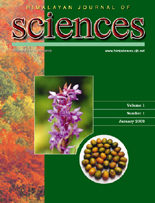Ethnobotanical notes on flora of Khaptad National Park (KNP), far-western Nepal
DOI:
https://doi.org/10.3126/hjs.v1i1.182Keywords:
ethnobotany, flora, Khaptad National ParkAbstract
The complex geomorphology, climatic variations and vegetation have made Khaptad National Park (KNP) flourish with diverse flora, which, in turn, has made a treasure home for luxuriant growth of plant resources especially medicinal herbs. This paper aims at highlighting the ethnobotanical account of wild plants, their traditional utilization, chiefly as medicine, food supplements and other economic uses in KNP. Personnel interviews and group discussions with local inhabitants (local healers, traders, women and experienced and aged persons) were consulted for seeking information on local uses of plants, which was further authenticated by crosschecking. Different sites were accessed along altitudinal gradient from Silgadhi to Chhodipatan comprising 1400-3250 masl. Altogether 211 plants species comprising 188 genera belonging to 88 families were recorded. Among them, 81 species were used by local people for various domestic purposes. It has been found that 51 species of them were used for medicinal purposes, 11 species as vegetables, 6 species for ornamental purposes, 18 species for construction, furniture and making agricultural implements and 10 species for miscellaneous purposes. This wide ethnobotanical uses, diverse ecology and its great natural beauty deserve the attraction for researchers, tourists and other people. However, at present, the rich wild flora of KNP is under threat due to habitat destruction, overexploitation, and gradually declining traditional ethnobotanical knowledge, indicating an urgent need for conservation. Himalayan Journal of Sciences 1(1): 25-30, 2003Downloads
Download data is not yet available.
Abstract
2147
PDF
3673
Downloads
How to Cite
Kunwar, R. M. (2006). Ethnobotanical notes on flora of Khaptad National Park (KNP), far-western Nepal. Himalayan Journal of Sciences, 1(1), 25–30. https://doi.org/10.3126/hjs.v1i1.182
Issue
Section
Research Papers




